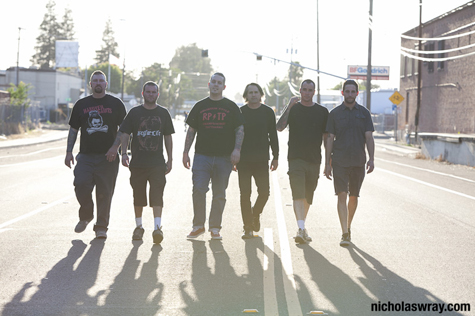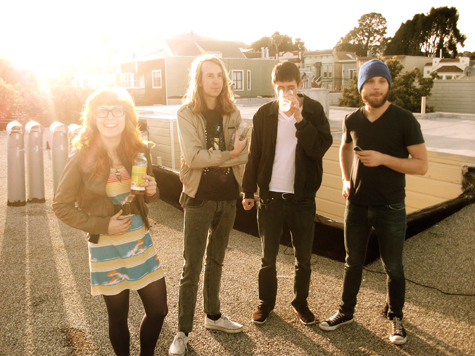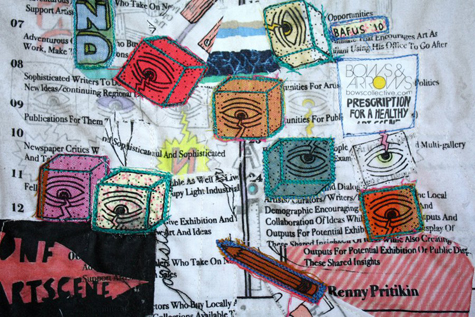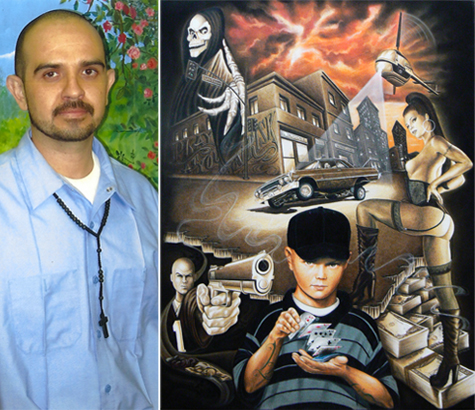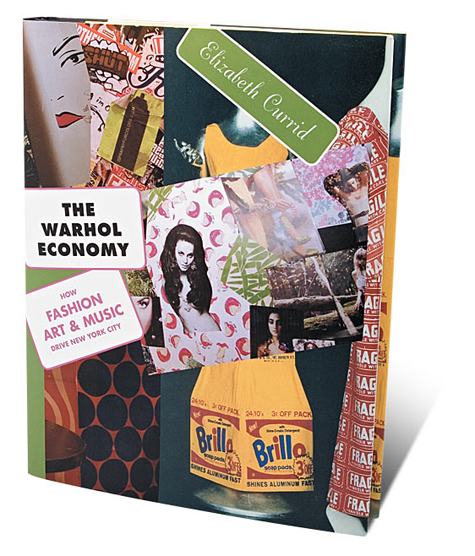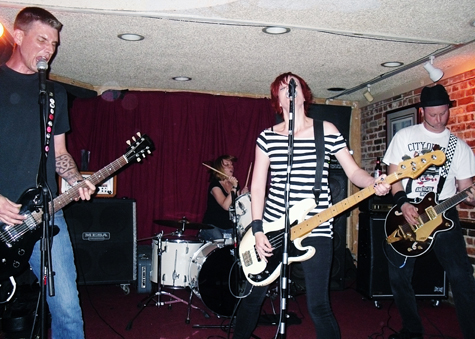Demetris Washington becomes a better man through art

Photo by Edgar Guerra
As a toddler, Demetris Washington used to think of the world as his own personal canvas. He started off as would any other child, scribbling on anything and everything he could grasp with his tiny hands. To his mother’s disadvantage he would create pieces of art on the walls, the floor and sometimes even paper. “When I looked at my ultrasound, I was in my mom’s stomach and there was a pencil right next to me. I had a palette and everything,” Washington joked while eating an oatmeal cookie outside of Sugar Plum Vegan Cafe. “When I came out [of the womb] I had a No. 2 pencil. The doctor was like ‘He’s going to be an artist.’”
In elementary school, Washington began to create comics with his own characters that left his family wondering where his imagination would take him next. “I never had fun drawing other characters. I never drew The Hulk, never drew Superman or anything like that,” he said. “I always came up with my own characters. My uncle was always asking, ‘How do you come up with this stuff?’”
While attending high school in Stockton, Calif., the realization that art can become a career started to settle in after he got paid to paint a mural of the school mascot in the boys’ locker room. “I really hyped the team up with that one. Every time they came in [the locker room] I could see their faces lighting up. And I thought, I really like this reaction I’m getting out of them, this is beautiful. People are happy with what I’m doing and I’m getting paid,” Washington said. And while getting his associate degree in graphic design at The Art Institute in Sacramento, he boldly tangled the worlds of comic books and graffiti to form a unique genre of art that he has righteously claimed as BAMR. “Becoming a Man Righteously. For a minute I was really skeptical about this name but when I began to tell people, ‘My name is BAMR,’ they would look at me weird. And that’s the reaction that I wanted, for people to look at me weird but then I tell them what it means,” Washington said.
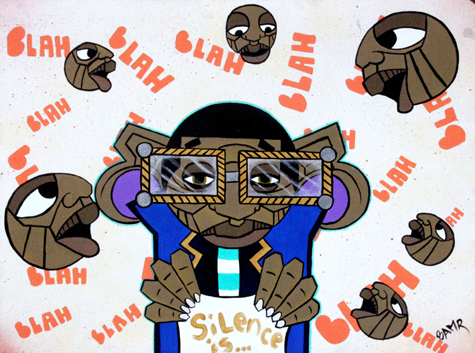
From scribbling on the walls as a toddler to attending art school, Washington has found himself working on projects for the Sacramento Kings, where he would paint on jerseys, shoes and billboards to raise money for charities. Now he has his own show, Building Legacies, at the adorable Legacy Boutique in Midtown. His artwork pops out at you because it is full of colorful characters and shapes that are dying to jump from the canvas and come to life. Although he did not want to draw mainstream cartoon characters as a child, he was inspired by one cartoonist, E. C. Segar, the creator of Popeye.
“If you look at my characters’ arms they look like they ate a little bit of spinach before they went out,” he said with a laugh.
One piece, called Head Above Water (pictured last/used on cover), shows a man with most of his body submerged in water except for his head. The piece represents Washington starting off as an artist who can finally breathe after beginning to make a name for himself and get more freelance work, he said. Most of his vibrant art pieces are based on his life experiences and ideas that he comes up with, normally between the hours of midnight and 5 a.m.
“I do the paintings at night because it seems like that’s when the ideas come to me, when I’m supposed to be asleep, when I’m supposed to be dreaming. It’s like I’m awake but dreaming at the same time,” Washington said. “I don’t need drugs, I got enough in my own mind. That’s another reason why I paint, because I have the hopes that everybody sees what I’m seeing, so I don’t feel crazy… I sit there and I’m literally struggling to stay sane. I’m sitting there painting and all these thoughts and ideas going through my head and nobody to share it with except this canvas.”
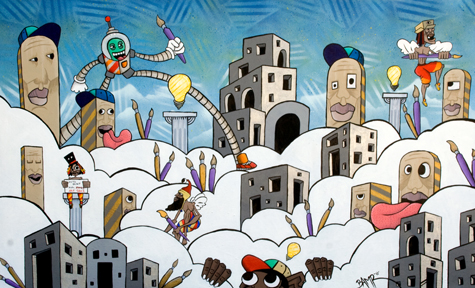
Washington uses his one-car garage as an art studio, which can no longer fit a car in order to store all of the art supplies. But these days he is feeling a bit “too big for the castle” in the small garage and hopes to move to Los Angeles by the beginning of next year and find a bigger studio to work in. After living in so many California cities, such as Monterey, Oakland, Hayward, and Stockton, he doesn’t like to compare the Sacramento art scene with other cities. “I see it as squeezing the last of the toothpaste. Definitely a beautiful place to do art but maybe not as many opportunities for every artist, for every style,” Washington said. “I feel it’s kind of biased. But I’m here, and Sacramento has been good to me, so I’m thankful for it.” Outside of his small Sacramento garage, the 20-year-old freelance artist and graphic designer makes sure to balance his social and work life by finding time to spend with his two young sons.
“They really are the reason why I do everything that I do. I want make an impact on their lives. I wasn’t able to spend so much time with them, because I was working so hard just to make sure they had what they needed,” Washington said. “And I realized what’s more important is the fact that I’m there for them. They get material things but it’s not going to fill in that void where love belongs. So I had to stop for a second, pause and spend more time with them. You can’t become a man righteously if you have two sons that you’re not there for.” But finding time for his family is evident because inside of his sketchbook, which is filled with his own intricate drawings, there are the occasional scribbles from crayons. Washington proudly pointed out the different art techniques that his 2 and 3-year-old sons have created on the pages from coloring with crayons. Demetris encourages his young sons to be creative and let their imagination take over, just like their father’s. “People look at my work and say, ‘Dude how do you come up with this?’ I was going to ask you the same thing. I don’t know how I come up with it. It’s just there.”
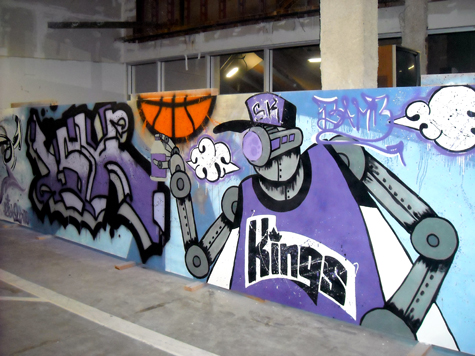
BAMR’s Building Legacies is now showing at Legacy Boutique, 2418 K Street, Sacramento. The exhibit is free and open to the public. For more info, call the boutique at
(916) 706-0481.
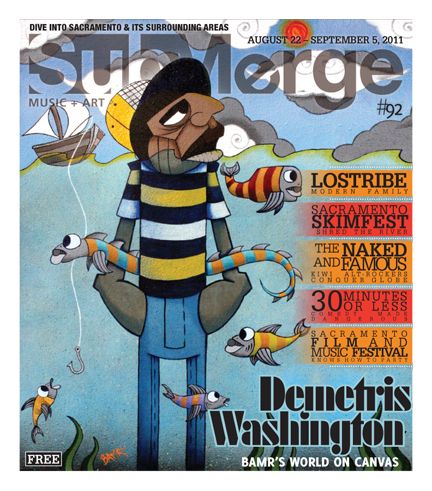
Kill the Precedent load up with a new EP
Industrial metal might conjure images of military-like precision with perhaps a totalitarian-style frontman at its controls. Kill the Precedent certainly evokes those images with their music. Thundering beats–both live and electronic–blast behind thrashing riffs and the two-pronged vocal attack of Twig the Exfoliator and The Ugly American. However, speaking with the two vocalists in a recent interview, the guys seemed jovial, bordering on jolly. For instance, if you were to call The Ugly American’s cell phone, you might hear The Dead Kennedys’ classic “California Uber Alles” playing while you waited for him to answer your phone. He said that since Jerry Brown was re-elected as governor, it seemed appropriate. “It’s such a fucking mess out here,” he quipped. “I thought it was pretty damn funny. At least it’s not an actor.” If KTP was indeed an army, in demeanor, they’d be more akin to the cool jokesters from Stripes than the cold-blooded killers of Full Metal Jacket.
Make no mistake, though; the band’s music is a no-holds-barred aural assault. KTP is ready to release a new EP, Stories of Science and Fantasy, which will consist of six original songs and two covers (The Smiths’ “Death of a Disco Dancer” and Jessica Lea Mayfield’s “We’ve Never Lied,” which Twig says was recorded in a hotel room in Oakland). Evoking the days when bands like Ministry and KMFDM crashed mainstream rock’s party, songs such as “Questions for Weapons” wield an imposing arsenal or metal riffs and huge beats, courtesy of electronic beatsmith/guitarist Hamburger, guitarist Killsbury and drummer Sgt. Pepper, while “Free Reign” is a throbbing, almost dance-y track highlighted by Jon the Jew’s pummeling bass line and an underlying, monolithic electronic groove.
Members of the band are no strangers to the Sacramento rock scene. They have played in bands such as Red Tape, Diseptikons and Rivithead in the past, but Kill the Precedent started as a side project of The Ugly American and Hamburger.
“Hamburger and I got together in 2006 and started screwing around with the drum machine,” The Ugly American explained. “We were kind of doing a little Big Black kind of deal, just having some fun. We recorded some music and got a hold of Twig, and I said, ‘I got to record some vocals, can you come down and help me out?’ We recorded vocals. Twig and I had been friends for many years, and he was giving me this blank stare, so I was like, ‘OK, you didn’t like it, but thanks for coming down and recording.’ And he said, ‘No, I want in. I’m fucking in.’ He took over from there.”
Twig’s introduction to the band was through the song “Cop Out,” which will appear on Stories of Science and Fantasy. More songs were started, but Twig said they were left unfinished. As each new member of the band became a permanent fixture, the songs began to flesh out.
“I wanted Killsbury to put a guitar riff over that–just that one song [“Cop Out”],” Twig said. “I’ve been in bands with all these other people in Red Tape and Diseptikons, and I was like just do this one song, but then it became do this song and that song…and eventually that’s how each member has come to be in the band.”
For The Ugly American, Kill the Precedent became a way of rediscovering the music he loved to make in the late ‘80s and early ‘90s with bands such as Rivithead and Battalion 53 after years of playing in punk bands.
“It dawned on me that I really missed that shit,” he said. “It was powerful, it was fun, it was endless. You could do whatever you want and get away with a hell of a lot more.”
In the following interview, KTP’s two vocalists fill us in on the making of the forthcoming EP and what draws them to making this kind of music. We find out that the reason why the harsh-sounding vocalists are so jovial is because they’re playing music they actually love.

It seems like industrial is a genre of music that’s gone back underground. Is that part of the excitement of revisiting it?
The Ugly American: Kind of, but not really. There’s no denying that those bands have had an influence. It’s obvious–and it should. It’s fucking awesome music… I can just say I missed the power of it.
Twig the Exfoliator: I liked the freedom of it. When we first started jamming around, with Jeremy from the Snobs, the bass player, was doing a bunch of electronic beats and me and [Ugly] would sing over it. It wasn’t hip-hop singing, but it was like a Fugazi overlay over dance music. I definitely wanted to not do just Ministry type stuff, but I wanted some melody in there to make it a bit different.
Listening to the music, you can definitely hear that sort of punk-type melodies.
Twig: Whatever [Hamburger] makes up beatwise and gives to us, half of them could be more on the dance side, some of them are more hard and fast, or slow and driving. If we hear something that we like, we’ll get working on that. Part of the reason why I wanted to do this was because I didn’t want to work with drummers anymore [laughs]. I was mad at all the drummers I’ve ever played with, and they take too long to set up. I was sick of loading all their shit into my van. That was the original idea, “Oh, we do whatever. We don’t need a drummer. Be like a hip-hop band, just plug in an iPod and do it like that.” That’s the way I wanted to do it. I wanted to put on a big production of a show, but within our budget.
Ugly: When Twig was on tour with Hoods–I think they were in Europe. He was adamant about it. He was like, “No drummers. I don’t want any fucking drummers.” Before we even put a drummer in there, I wanted one, because I wanted to add to the power and the beats and make it sound as large as we could. But he was all, “Hell no, we’re not doing it.” So, he goes to Europe and we grabbed our old buddy [Sgt.] Pepper. We brought him in to practice while Twig was gone. When he got back, he showed up for practice, and we were like, “Oh look, it’s…Pepper.” He was like, “You dick.” [Laughs.]
Twig: [Laughs] But it worked out.
Twig, you said you came in and did the middle section of “Cop Out,” but after doing that you wanted in. What drew you to this project?
Twig: I wanted to do something different. I wanted to do drum machines and just sample stuff by myself, but I’m completely computer illiterate. I don’t know how to do any of that stuff, and I couldn’t get anyone to do it. I talked to [Ugly], and they were already doing it for a couple of months, so I went in to record with them. The beats were big and huge, and it was something different. Since he let me even try something, and I could overlay a couple different vocal layers, and me and Sean could go back and forth instead of having to write a song’s lyrics all by ourselves–and you know, run out of breath–it made it better that we could share the vocal part. I liked that. I liked who he was working with, because I had known [Hamburger] from Rivithead and Battalion 53. We were also working with Evan at that point, Tha Fruitbat.
It seems like everyone who has come into the project has left their own stamp on it. Is that how the songwriting goes or do you start with the beats and go on from there?
Twig: Hamburger does all the beats and stuff. He’ll do two different parts with maybe some guitar, because he plays guitar too. He’ll just send us two-minute loops so we can get an idea about it. Then usually we will come up with singing structures, and then we’ll leave it alone. We won’t finish anything, and then we’ll bring it to practice and everyone else will listen to it and have their input. We start arranging the songs from there, cutting out parts, changing the drum beats, adding different parts, then we actually start writing the songs, the lyrics and stuff.
Ugly: It goes in reverse. It’s not the typical way you write a song, but it’s totally working for us.
Twig: Everyone’s really busy, so it’s all sent over the computer. Hamburger will send the beats to us, and we’ll pick the ones we like–the whole band will. And we’ll just work on it from there.
A lot of the bands we were talking about as influences before are largely associated with one guy, like Al Jourgensen for example, but it sounds like you guys actually play the songs to write them, which I think is kind of interesting for industrial music.
Twig: It’s like any other band. We’ll start arguing…but it all works out in the end as long as no one’s picky and tries to be the highlight of the song. Everyone knows their place.
Ugly: There are no egos, arrogance or bullshit. I know this sounds hokey, but it’s a completely collective effort. Everyone has their say. Like Twig says, we’ll argue to friggin’ death over it, but everybody’s got their two cents, and it just keeps piling things on without making it too much. It’s one cool idea after the other. It’s fun. I think the biggest thing is just that it’s a hell of a lot of fun.
I’ve seen that you guys have had girls in costume dancing at the shows, people covered in blood, synching up videos to your songs. Is that something you get together and collaborate on?
Twig: [Killsbury] handles most of the video stuff. He takes a while to get it with the beats and intros to every song. Except for [Hamburger], none of us are that great with computers. To do all that is a bit of a learning experience. And we don’t do it the way we should. We’re rolling into shows with DVD players and stuff, and a projector from like 1992.
Ugly: We try to change it up every time if we can. We did a good run, if you don’t mind me saying, at Blue Lamp. We called it “Cocaine Drug Dealers” or “Colombian Drug Dealers.” Everyone in the band was dressed up in cammo and we were dressed up in white suits. I filled up a bunch of baggies with flour. It was a great show, but it was the stupidest thing I ever did. Twig and I started throwing these bags of flour out into the audience and hit a fan. It went everywhere. Everyone was covered. I got off stage, and the guy was like, “It’s going to be $450 to clean up the place.”
Twig: It’s kind of like having sheet rock down or something. You can’t get rid of it… All the bottles were covered. We were like, “$450? No, we’ll come in tomorrow.” So we were hung-over as shit, and we had to be there at noon the next day. He was waiting for us with the mops, and he’s like, “Here you go.” Of course he opened the bar, and we got drunk and cleaned that place for four or five hours, and I can say it’s the cleanest it’s ever been [laughs]. It’s the cleanest club in Sacramento.
Kill the Precedent will play an EP release show at Harlow’s on Aug. 6, 2011 with Will Haven, The Snobs and City of Vain. Tickets are just $10 and can be purchased through Harlows.com. For more information on KTP, like them why don’t you at Facebook.com/killtheprecedent.
David Mohr expands his musical horizons with Favors
The breakup of Sacramento’s 20,000 was a complicated one. The group had an electro-Sonny and Cher thing going on, until it imploded at a fateful summer night’s show. David Mohr, one half of 20,000, was Cher in this scenario, in that it led to songs in the vein of “Bang Bang (My Baby Shot Me Down).” Assuming the moniker of Favors, Mohr’s series of fractured digital EPs sought comfort in the familiar synthesizer framework, a kinship with Lou Reed’s “Hangin’ Round” chorus and anti-anthems that put weekends and summers in their crosshairs.
With the heart pain now out of his system, Mohr is exploring the futuristic vision his friends have always associated with the bedroom project before he was able to see it. “I started writing these songs when I was living with the rest of the band, so that is over a year’s worth of songs that I picked from to form this album,” Mohr said. “So in that time, I basically started feeling like there were a lot of different subjects I hadn’t approached yet with Favors, and I wanted to open it up so that the future of the band could go in any direction.”
The band he lived with was once called Impotent Ninja, which consisted of Ben Lewis, Chris Metcalf and Crystal McCarthy. The house mates have since gone their separate ways, but their time together allowed Mohr to get in a better place that led to the completion of Five Million Years, a record which is somewhere between sugary synth-pop and music that can help break a healthy sweat. “The songs I write will always have a pop element to them, I think,” he said. “Unless I become so involved in it that I lose focus of what it means to be pop. But I don’t know. I like fun songs. I like dance music and I like electronic music. My friend’s little sister said that Favors sounded like ‘workout music’ when she heard it. That’s perfect.”
When I last talked with you, Favors was a bedroom project of EP releases with a lot of post-breakup songs. Listening to the new record, it seems as though Favors is exploring abstract territory, with songs of starships, cash-machines and caves. What brought this change in songwriting?
A friend of mine said that Favors sounded “futuristic” to him, and I thought that was funny. I had never thought of it like that, so I thought I would push the science fiction element in some of the songs. I was hesitant to do that at first, because I didn’t want the songs to feel too distant or detached from reality, but I kept reminding myself that David Bowie wrote tons of futuristic space age songs, but it took me years of listening to ever realize that. They always just sounded like awesome songs from the ‘70s. Maybe I don’t pay attention to lyrics.
Now that you mention Bowie, I feel like the album title Five Million Years is just an extension of Bowie’s “Five Years.”
The album title Five Million Years comes from my desire to create a larger time frame and a more expansive imaginary space for the listener to step into. I’m interested in the way that time can be distorted by music, like how fast songs can make the listener feel as if time is moving quicker. It’s strange; music is very connected to our concept of time.
Favors is a full band now, but what’s the recording process like? Is it done as a band or do your band mates learn the songs after you’ve created them?
In terms of songwriting and recording, Favors is still a bedroom project. I write and record the songs on a laptop at home. The live band was formed at the very beginning; it was always Chris, Ben and Crystal, but it just took some time to get things going with that part of the project. Usually I’m working on music alone, but I always wanted the live band to exist as well. It’s nice to have a group to share it with, and it makes practicing and playing live way more fun. During practice of course, everybody contributes their own touches, and of course Ben is a wizard on guitar, so we have to incorporate that. Everyone is amazing at their instruments and is way beyond me in musical ability. I’m very lucky to have friends who want to play the songs.
You don’t see many indie bands with a frontman. Was it weird at first to have no instrument responsibilities on stage?
I’m really not a very good musician, so playing keyboard on stage is difficult for me. I thought it would be best if I just focused on the singing, that way I can express something that the music isn’t expressing live. I still feel uncomfortable performing live, though; it definitely feels like the fakest part of the whole thing for me. But that doesn’t mean I’m not trying to do my best.
From what I’ve seen, you’ve taken to the art of being a frontman. Were there any famous lead singers you took cues from?
David Byrne became a huge inspiration early on. He added so much to the music just with his movements and appearance on stage. Of course he was a great guitar player and a great musician, but I was most intrigued by his gestures. It seemed like he was really thinking on stage, and channeling that into the songs.
Have you gone for the cord windmill and catch the mic maneuver yet?
I used to do the windmill cord spin in my first band. I was really good at it, but I had to duct tape the mic to the cord so it wouldn’t fly off. I’m too old for that now. My favorite part about live shows is when things start going wrong, though. It’s fun to try and make the best of it and keep the show going. During our last show, Crystal’s electronic drum set kept falling apart because I had broken it in half while loading gear on stage. Chris had taped it together before we started, but I had to keep lifting it up for Crystal while she played. I love those moments. Things start falling apart so quickly that trying to fix them becomes ridiculous.
The cassette culture is on the rise, but has not quite hit Sacramento yet. Why did you choose this format?
I’ve always wanted Favors music to be available for free. I think that anyone who wants it should be able to have it. Also, I don’t know too many people who pay for music anymore, and I especially don’t know very many people who buy CDs, so I thought I might as well do a cassette.
It’s still nice to hold something in your hands that represents the music. I think the same reasoning goes into vinyl production, but personally I have more of a nostalgic connection to tapes. The first music I owned was They Might Be Giants’ Flood on a cassette that I bought from my brother. I listened to records as a kid, but I had a more personal connection to tapes. I used to make cover art for cassette tapes of made-up bands years before I ever started writing music. Despite all the nostalgia and my love of cassettes, there is also something funny about releasing tapes now in 2011. I like the fact that I recorded the music on a computer but I’m putting it out in a medium that degrades the quality and its near obsoleteness. It’s a wink backwards.
The bonuses are that it is really cheap to do and they look cool. I had fun designing them and putting them all together. It’s also funny to see people’s reactions. At least one member of Favors thinks releasing a cassette is a terrible idea.
Terrible idea or not, Favors’ new album Five Million Years will be available on cassette around Aug. 1. You can order a copy and get a free full digital download at Favors.bandcamp.com. Check out the band live to celebrate the release of the album at The Press Club in Sacramento with Evan Bailey and The Happy Medium on Aug. 4.
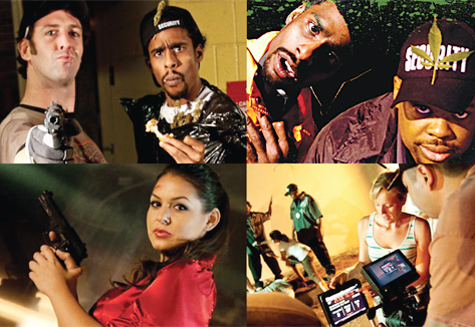
Left and Loose in the Lot is a hilarious locally produced comedy about two stoner security guards who witness a murder while working the night shift at a parking garage, which throws a serious damper on their night that just seems to go from bad to worse. Starring local talent Waynee Wayne, host of KSFM 102.5’s morning show and Demetrius Dedmon, also a 102.5 DJ, the Lot was shot entirely in Sacramento and Folsom. Also featured in the film is Hollywood actor/producer Christopher Michael Holley, who has worked alongside Joe Carnahan, Kevin Spacey, Edward Norton and Jeremy Piven on such films as Pride and Glory, 21, Smokin’ Aces and more. The Lot is also the first film from writer/producer Dawn Dais, a Sacramento native and best-selling author, so there is no denying the amount of local talent behind the making of this film. The official press release says the Lot is “Harold and Kumar meets Bad Boys,” and based on the film’s trailer we would say that is a pretty accurate description. Toss in Half Baked and How High and you’re almost spot-on. The entire cast and crew, along with some other special guests, will be at Crest Theatre (1013 K Street) in Sacramento, on Friday, Aug. 5 for a red carpet event starting at 6:30 p.m. There will also be a film screening, which is technically the “world premier” of the Lot, at 7:30 p.m. For more information about the film, to view the trailer and to purchase tickets to the premier for just $5, visit Leftandloose.com.
What makes an art scene “healthy?” If you find yourself answering that question with something like, “artists and art galleries, duh!” then Bows & Arrows’ Prescription for a Healthy Art Scene exhibit, opening on Friday, Aug. 5, is sure to expand upon your notion of what makes a thriving arts culture in a community. The exhibit is inspired directly by the writing of Renny Pritikin, director of the Richard L. Nelson Gallery and the Fine Arts Collection at U.C. Davis, who originally penned his “Prescription for a Healthy Art Scene” list many years ago. “I was on a panel years ago, 15 years ago maybe,” remembered Pritikin during a recent conversation with Submerge. “And I can’t even remember what the topic of the panel was, but those were my notes for what I was going to talk about. It’s one of those things where you never know what project that you take on is going to really stick with you and have a life of its own and which ones will just be forgotten. I’ve done exhibitions that I didn’t think much about, that I just threw together and they became famous, you know, and ones that I worked on for years that I thought were incredible that nobody cared about. I’ve written things that I thought were major and other things, like this, that were almost a throwaway but have gone on to have a life of its own.”
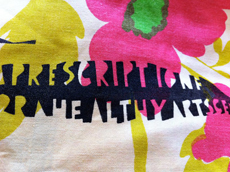
Pritikin’s “Prescription” is made up of 24 bullet points ranging from, “No. 1: A large pool of artists, there’s a critical mass or tipping point that makes a scene,” to “No. 8: Sophisticated writers to document, discuss and promote new ideas/continuing regional development,” to “No. 17: Articulate artist leaders,” to “No. 23: Events that bring people together, scheduled multi-gallery opening nights for example.” The list is a sort of Holy Grail for any advocate of local art, including Trisha Rhomberg, co-owner of Bows & Arrows. Rhomberg came across Pritikin’s writings online over a year ago and was immediately touched and inspired by the list. “I saved it to my desktop and I read a bunch of articles online about it and I kept reading it to myself,” she said. “Then I got my sketch book out and wrote the whole thing down by hand so I could start to memorize it and think more about it. Then I was like, ‘Oh my God, wouldn’t it be cool if all my other friends and artists I know could draw a piece of this and we could do a project together?’” And so the idea for the Prescription… art show was born.
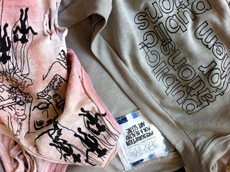
Rhomberg collaborated with over 20 local artists, all of whom took items from Pritikin’s list and transferred them onto T-shirts. “Man these shirts are looking cool,” Rhomberg said excitedly. “Every day I’ve wanted to wear one of them. I just want the word out.” One wall inside Bows will feature the Prescription blown up for all to read. The other wall will feature select T-shirts and maybe even some of the artists’ original illustrations framed. Plenty of the shirts will be for sale, too, so not only can you soak up knowledge about what makes an art scene healthy, you can take a piece home with you to wear, spreading the message further and further. After all, that’s the whole point of this thing. “It really is the most important thing I’ve ever come across,” admitted Rhomberg. “And I’m really excited that it has been working. People are working together and learning new crafts and are being supportive and becoming more aware of each other and of each other’s talents and where they live and what they do and participating in buying art, which is what we’ve set out to do.” For more information, visit Bowscollective.com
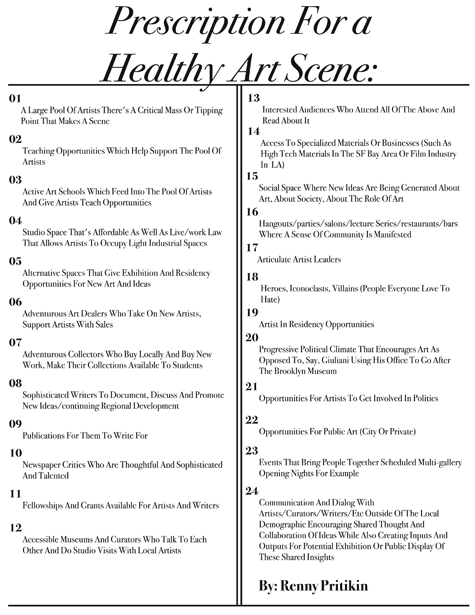
Salvador Aceves finds art behind bars
The art of Salvador Aceves displayed in Spanglish Arte gallery on the corner of 23rd and I streets depicts the graphic and unforgiving lifestyle of the prideful Latino gangbangers. At first glance it is a glorification of the lascivious and criminal temptations of a deviant youth. But dismissing Aceves’ collection as such is a crime. Aceves’ “gangster’s paradise” is the work of an exiled man confronting his last chance at redemption.
Aceves was incarcerated at the age of 17 for first-degree murder, after living in the United States for two years. His family moved as illegal aliens from Jalisco, Mexico to Santa Ana, Calif., in 1989. His infatuation with the neighborhood gangs began with fights at school, arrests and short trips to the California Youth Authority juvenile halls. By age 19 he was in a Level 4 maximum security prison serving a 25-to-life sentence.
Aceves discovered art in prison, and with not much of a life lived on the outside, he drew from what he knew–gang life. His drawings were not done in admiration, but to escape perdition by facing his memories and exploring the deceptions that lead to a banger’s demise. “When I first came to prison I didn’t know how to draw, much less paint,” Aceves wrote in a letter to Submerge. “Interested in the arts, I collected any kind of art material I was able to get my hands on. Then through a quarterly package, my sister sent me a tablet of Bristol board paper and a set of 48 Prismacolor pencils, and it was then that I discovered color and fell in love with it.”
With three years remaining in his sentence, Aceves’ communication with the outside world is limited. Our correspondence was restricted to a letter sent and a letter received, but it was clear from our brief exchange he is not the delinquent that entered prison. The tough-mindedness instilled in him as a “graduate of C.Y.A.” has matured into wisdom to warn future generations of the perils of the lifestyle. Through the poetry and stories written alongside his artwork, he presents a deeper criticism of gangs often overlooked by outsiders who either glorify or brutalize the culture.
The following is pieced together from our correspondence, in which Aceves explains the discovery of his talent and the failing institution of C.Y.A.

I’m curious as to how long you were in a maximum-security prison before the opportunity to profit from art became apparent to you. Did you discover the venture on your own or did the art bring recognition, which then prompted a figure within the prison to inform you of the profits possible?
It never crossed my mind then, I just did it because I truly loved and enjoyed doing it. And I never forget the first piece I ever sold. It was a drawing I had up in my cell-wall, and this guy that used to pass by my cell all the time… one day he asked me if it was a poster, and he offered to buy it, to put a price on it. Of course I didn’t know how to price my work. He offered $25, and I was satisfied with that. I was just happy and proud that someone was willing to pay for something I had enjoyed doing. And that’s how it started really. It was other inmates that priced my work, and the old law of supply and demand came to apply in my case. I could only produce so many works a month, so they would offer to pay more just so I could do a piece for them.
As you were probably informed I was incarcerated at 17 years old. My parents, disappointed and demoralized, returned to Mexico only three weeks after my arrest. So from the beginning I was left to fend for myself, so at the beginning I only made enough money to pay for the basic necessities. Hygiene items (toothpaste, soap, deodorant, shampoo, etc.), a little bit of food.
When I started to profit a little more I made a point of saving some of the money I made. After paying for supplies and the things I needed in here, the rest of the money I sent to my sister and it was through her that I managed to invest in bonds and mutual funds (the safest for a long-term investment). At the time my release was inconceivable I just decided to save for “future emergencies.” But last October when I appeared in front of the BPH [Board of Parole Hearings] I decided to hire a private attorney to represent me, and much of this money was used, so I’ll have to start from zero again.
The images you create are striking considering the length of time you’ve been imprisoned. I had not considered the image of a young Mexican male embracing a gang life to be unchanging in style or mentality since the late ‘80s. It’s as though your images present the Mexican gangbanger as iconic. Would you agree? Are your drawings purely based upon the life you once lived in Southern California or is there a modern influence at play either from images you’ve obtained in prison or from communicating with newer inmates?
Yes, I agree and I believe people of different ages can identify with the concept of my images present. Much of my drawings are based in the life I have lived and of those around me. However, yes, I allowed myself a modern influence of dressing style and maybe a car model with the sole purpose of presenting my younger peers with images they could identify with–with something that was familiar and immediate to them.

What prompted me was exactly what you mentioned, I did not wish my art to be mistaken as a glorification of gang-life. It was also a futile attempt of explaining the why of “IT.” The why of this love, but how can you explain the thousands of wasted lives, some dead, some locked up doing life, for something that really makes no sense?
It’s interesting that around the time you were convicted, there was a shift in the effectiveness of the once innovative California Youth Authority. It seems as though your experience with the C.Y.A. was more of a rite of passage that accelerates a youth’s understanding of gang life–like it’s a university system for gangs instead of a juvenile corrections program. Is this an accurate comparison to the flawed institution? What is the “Y.A. mentality” you mention in your biography?
It is an accurate comparison to the flawed institution, and that’s why most of the C.Y.A. institutions that are left are complete lockdown institutions. The system has lost control of its own institutions. And to a young gangbanger it was a rite of passage. It was considered that if you “made it” through C.Y.A., you’ll make it through everything. It was a physical, but more than physical it was a mental game you had to endure, and in C.Y.A., the “weak” were separated from the “tough” real quick. Separated, labeled and outcasted, these “weak” guys had to go through hell. So you had no other choice but to fight your way through, fight and fight and endure ‘til you made it and graduated. And whether you graduated to prison or to the streets, you “made it” and we were proud to be called “Y.A. babies” ‘cause you were tough, ‘cause you fought, ‘cause you represented your neighborhood and your set gratefully, ‘cause you weren’t a punk, ‘cause you were “strong minded,” and you felt respected.
And this perception of yourself and the way you think others think of you gives you a sense of confidence and untouchability that fills you with boldness, fearlessness and a daring spirit to take on the world and this is the Y.A. mentality I talked about. This is the Y.A. mentality these youngsters take back to their neighborhoods, where they are looked up to, and it’s these youngsters that take their gangs and their neighborhoods on their shoulders and it’s a vicious cycle. Most of these youngsters don’t last. They either end up dead or back in prison with a life sentence over their heads, and statistics show that a high percentage of youths paroled from C.Y.A come back. So this is the Y.A mentality I wrote about.
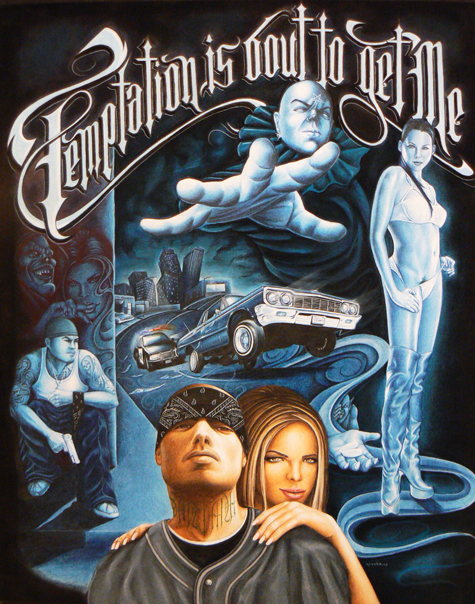

Salvador Aceves is in a medium security prison in Vacaville. While serving time and selling artwork from his cell, Aceves earned a G.E.D., a college A.A. degree in Liberal Arts and an A.S. in Business Management. In January 2011 the California Board of Prison Term set his release to approximately three years from now. Perdition, an exhibit of Aceves’ art is now showing at Spanglish Arte. For more info, go to Shopspanglish.com or call (916) 446-1213.
Osaka-ya
2215 10th Street – Sacramento
Words by Adam Saake
Photos by Nicholas Wray – www.nicholaswray.com
The term “hole in the wall,” often used to describe the tiny joints that warm our big hearts, takes on a new meaning when we’re referring to an actual hole in a wall. In this case it’s actually a square–and on a hot day you’ll see arms protruding from this opening to hand deliver snow cones, fruit freezes or root beer floats to throngs of customers that congregate to cool down with something icy and cold. Next to the window, glass doors open to expose a small Japanese food market with dry and frozen items, and in the case by the register is a selection of manju and mochi. These little Japanese pastries aren’t filled with ice cream like what you might find at Trader Joe’s, but rather sweet red bean or lima bean paste and even peanut butter or custard. This is Osaka-ya, a Riverside-area sweets shop that’s been a Sacramento staple for almost 50 years.

Located on 10th Street between V and U streets, a weathered blue and white sign marks the historic confections shop and bakery owned by the Nakatani family. Longtime original owners Kenji Nakatani and wife Asako Sato, who have since passed away, bought the shop in the early ‘60s and operated using Sato’s original recipes for roughly 46 years before daughter and business partner Linda Nakatani took over in 2009. Osaka-ya began across the street and then moved to its current location, which was once a fish market. Now manju of different flavors, colors and assortments are baked fresh in the back bakery and sold to customers who have grown to know and love them.
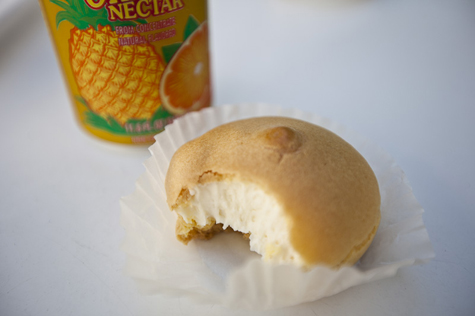
“I’ve been coming here for 30 years,” says Sacramento regular Deanna Preciado, who tends to order “something random” whenever she stops by.
Preciado didn’t look a day over 35, and that’s what makes Osaka-ya special. It’s one of the few places that some customers can say they’ve been coming to for most of their lives. We’re all sentimental about things that take us back to our childhoods, and the snow cones and manju are good for just that. When Submerge arrived, there were 20-some-odd people out front who ranged from small children to older folk in their 60s or 70s, each one there for something sweet.
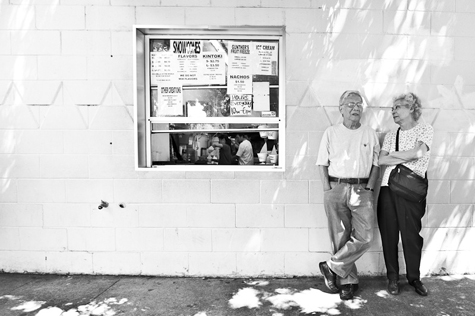
Manju is the general name for the traditional Japanese treats baked and sold at Osaka-ya. Mochi refers to the manju with a sticky, glutinous outside that has a sweet red bean paste in the center. If you’ve never had one before, it sounds adventurous; red beans inside a chewy exterior? But once you take a bite, you realize why so many people swear by these little delights. If “chewy” isn’t your thing, other varieties have a cake bun outside that sometimes have flavors like green tea, strawberry and coffee worked into the batter. Another popular variety has a peanut butter chocolate chip filling, and if you’re into creamy, we recommend the chou creams, a French puff pastry with vanilla custard that is often enjoyed frozen. Grab a cold Japanese UCC canned coffee from the mini fridge and voila! Afternoon delight.
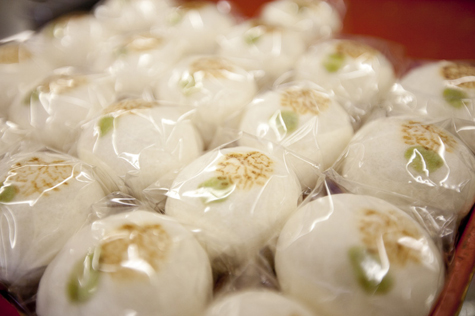
One of the more interesting flavors is called kinako ohagi, which has sweet whole rice outside, a whole red bean inside and is dusted with soybean powder. It looks a bit like a truffle and is traditionally served with tea. A Google search of kinaki ohagi led to various pictures of Kit Kat wrappers–one of Nestle’s flavors in Japan, apparently. Gimme a break? Bring it on. Also, look out for the special sakura domyouji-ko mochi, which are wrapped in cherry leaves. These are usually only available in March for Hina Matsuri, or Japanese Girl’s Day. Hina Matsuri is a celebration of Japanese girls and sakura mochi is food traditionally served. Don’t worry, Osaka-ya will still sell you one even if you’re a boy.
There’s a lot of cool historic stuff in Sacramento, but most of it is Victorian housing or behind ropes. There are few places left like Osaka-ya that is half a century old, owned by a family born and raised in Sacramento and selling confections the same way they did all that time ago. History in every bite.


On Tuesday, July 19, Ace of Spades will host the 2011 Sacramento stop of the Scream It Like You Mean It tour, featuring headliners Breathe Carolina, a Denver-based genre-crashing electronic/rock/pop/screamo duo. Chiodos, I See Stars, Modsun, The Air I Breathe, The Color Morale and Sierra Skyline are also on the bill. This all-ages show starts at 5 p.m. and tickets are available for $19.95 online at Aceofspadessac.com. Tickets are also available at all Dimple locations, The Beat and Armadillo Records. Ace of Spades is located at 1417 R Street in downtown Sacramento.
The Warhol Economy is a fascinating book that we think many Submerge readers would enjoy. Penned by Elizabeth Currid-Halkett, the book focuses on how art and culture play such vital roles in a great city’s economy. It focuses on New York, sure, but the book is sure to hit home in creative communities everywhere, especially here in Sacramento. Currid-Halkett will give a keynote speech on Friday, July 15 at the 2011 Midtown Business Association Annual Gala, taking place at Harlow’s (2708 J Street, Sacramento). Visit Mbasac.com for more details.
Armed Forces Radio, Riot Radio, Joe Q. Citizen, Killdevil
Distillery, Sacramento
Friday, June 17, 2011
“I thought punk was dead,” someone recently said to me during a conversation about music. It’s a tiresome, ongoing debate that gets people way too worked up, and this writer has no desire to engage in it. However, for someone who hasn’t seen too many punk shows lately, the Distillery’s primarily punk lineup on June 17 led me to believe that punk music, regardless of style, is alive and well. The lineup included four bands (three of which were local): Killdevil, Joe Q. Citizen, Riot Radio and Armed Forces Radio.
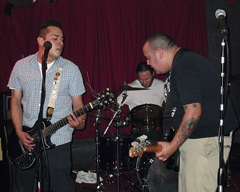
Killdevil
The night started off with alternative indie rock trio Killdevil, which didn’t quite fit the punk ticket, but delivered several energetic songs nonetheless. Songs like “Last Reptile” featured a signature indie rock sound, delivering distortion-packed guitar riffs as vocalist Alex Dorame wailed into the mic over the humming bass. Brothers Art and Alex Dorame have been playing as Killdevil for four years now, with Art on guitar and Alex on bass. The two praised their new drummer between songs for playing his first show with them live.
Next was Joe Q. Citizen, four guys hailing from San Jose, Calif. If a punk band can be classified as suave, these guys were proof. Their choice of gear was minimalistic, with only one pedal in sight. They didn’t need more. They commanded the stage with short, fluid pop-punk songs like “Dumb in Love” and “Diggin Out,” making their job look effortless. Guitarists Dover One and Shawn Packer strummed out swift chords over Julian Ostrow’s–whose shirt was off by the second song–fleet-footed drum tempo. “Whiskey in My Panties” was another favorite, garnering audience catcalls.
Four-piece band Riot Radio followed, the only band boasting female members that night. They are a newer band on the local music scene, and their sound fits somewhere in the midst of garage and hardcore punk. Vocalist/bassist Kat was full of piss and vinegar–who knew the petite, feathery-haired redhead could release such a powerfully raw, growling voice? It’s not easy to come by in a female vocalist. The band’s fierce drummer Maggie crashed away at the drums with gusto while Kat and guitarist Jeff exchanged nonstop shrieking call-and-response vocals, not a single word of which could be understood. Song after two-minute raging song should have left ears bleeding by the end of their set.
By the time Armed Forces Radio took the low-lit stage after midnight, the audience had thinned down to lone beer-carrying stragglers. The first song was introduced with the bassist drumming a beer bottle against his strings, leading into the song “Manifest Destiny.” Their songs had a punk/ska flavor and the Clash influence was unmistakable. More people magically appeared, gathering around the stage to watch as vocalist/rhythm guitarist Albert crooned anti-war songs like “Compassion of a Bullet” with the same raspy lisp as Joe Strummer. With beers in hand the crowd broke into a peaceful, short-lived mosh pit during “Ghosts of Babylon.” It was the most animated the audience had been the whole night. As the last song drew to an end, Albert was drenched, sweat and spit dripping down his chin.
What caught me by surprise was the fact he used a Taurus Polytone practice amp not much larger than a microwave to play the set, which he had positioned on top of a chair. Submerge caught up with him afterward to ask about it. The amp he usually plays with was in the shop, he said.
“Punk rock taught us to make do with what you have,” he said.
If that’s not a sign that punk is alive and kicking, I am not sure what is.






